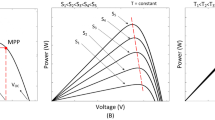Abstract
Wind turbines chains are increasingly used in the world and provide power, become important with technological developments. Through this present paper, we present work to improve the performance of wind turbines by the integration of a combined control mode with three different techniques: a classic PI controller, a Fuzzy logic controller and a matrix inverter. The results were much better compared to a combination without the matrix converter where the control decoupling between the active and reactive power is obtained successfully in more than a reduction of the harmonic distortion THD is very acceptable, which promotes improving the power quality produced by this type of wind chain.












Similar content being viewed by others
References
Das, A.K.: An empirical model of power curve of a wind turbine. Energy Syst. 5(3), 507–518 (2014)
Poitiers, F., Bouaouiche, T., Machmoum, M.: Advanced control of a doubly-fed induction generator for wind. Elsevier Electric Power Syst. Res. 79 (2009)
Xiao-Ming, G., Dan, S., Ben-Teng, H., Ling-Ling, H.: Direct power control for wind-turbine driven doubly-fed induction generator with constant switch frequency. In: Proceeding of International Conference on Electrical Machines and Systems, 2007, 8–11 October, Seoul
Kassem, A.M.: Modeling and control design of a stand alone wind energy conversion system based on functional model predictive control. Energy Syst. 3(3), 303–323 (2012)
Hu, J., Nian, H., Hu, B., He, Y., Zhu, Z. Q.: Direct active and reactive power regulation of DFIG using sliding-mode control approach. IEEE Trans. Energy Convers. 25(4), 1028–1039 (2010)
Frank, S., Steponavice, I., Rebennack, S.: Optimal power flow: a biblographic survey I formulation and determinatc methods. Energy Syst. 3(3), 221–259 (2012)
Garg, A., Sandhu, K.S., Saini, L.M.: Design and implementation of fuzzy logic controller for static switching control of voltage generated in self-excited induction generator. Energy Syst. 1–15 (2015)
Hu, S., Lin, X., Kang, Y., Zou, X.: An improved low voltage ride through control strategy of doubly fed induction generator during grid faults. IEEE Trans. Power Electron. 26(12), 3653–3665 (2011)
Ganesh, R., Senthil Kumar, R., Kaviya, K.: Fuzzy logic controller for doubly fed induction generator based wind energy conversion system. Int. J. Innov. Res. Sci. Eng. Technol. 3(6) (2014)
Rezaoui , M.M.: Study of Output Voltages of a Matrix Converter Feeding an Five AC—Induction Machine Using the Strategy Calculated Modulation PMW. Modern Electric Power Systems, Wroclaw (2010)
Hosseini, S.H., Babaei, E.: A new control algorithm for matrix converters under distorted and unbalanced conditions. In: Proceedings of 2003 IEEE Conference on Control Application (CCA 2003), vol. 2, pp. 1088–1093, Istanbul (2003)
Author information
Authors and Affiliations
Corresponding author
Rights and permissions
About this article
Cite this article
Ghoudelbourk, S., Dib, D. & Omeiri, A. Decoupled control of active and reactive power of a wind turbine based on DFIG and matrix converter. Energy Syst 7, 483–497 (2016). https://doi.org/10.1007/s12667-015-0177-1
Received:
Accepted:
Published:
Issue Date:
DOI: https://doi.org/10.1007/s12667-015-0177-1




